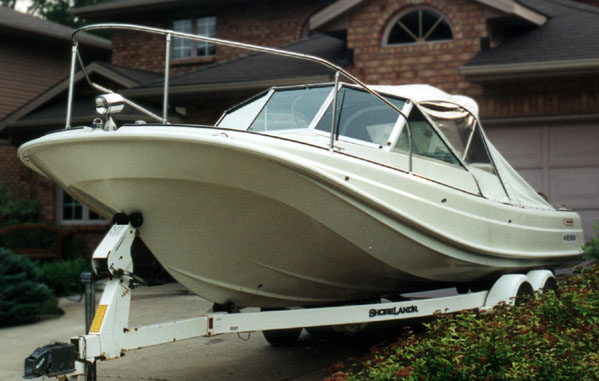
Dating from the late 1970's, the 21-Revenge used the Outrage hull and added a top molding. When you see the hull lines from this angle, you do want to say, "That is outrageous!"
PhotoCredit: JWH - Reference: 46-7
![[Logo: WHALER CETACEA]](graphics/cetaceaLogo230x60Trans.gif)
The Fisher-Pierce company had a knack for picking interesting model names for their Boston Whaler boats. First there were place names, including exotic spots like Menemsha (see Cetacea Page 25) which might have been well-known to down east boaters but sounded like the other side of the moon to a young boy in the midwest. After place names, there came a series of boats named after emotions, like "outrage." Even today, amid the prosaic nomenclature of a Two-Seventy-Five model, we still have the Dauntless and Defiance lines of boats being made.
According to canvas maker Jamie Mills, his father might have inspired the use of the Outrage nameplate by his initial reaction to seeing the new 21-foot hull the boys in Rockland were developing: "That's outrageous," he told Dick Fisher when he saw it. (Jamie tells this story in his wonderful contribution to Whaler Radio.)
Given antecedents like that, I cannot help but wonder what inspired the use of the name "revenge" on a series of cuddy cabin models. Who was taking revenge, and upon whom? This would be an interesting tale to have told. Perhaps there are some old hands from the Rockland era who might be able to give us the insider scoop. When your boat has the word "revenge" in its name, there is probably a story in there somewhere.
In any case, this leads me up to the boats presented here, all Revenge's and photographed by Steve and Charles Warren, Tom Clift, and me. Most are 21- or 22-foot boats, the most popular models. In some years there was also a 20-Revenge available, which was really the identical boat to the 22-Revenge with two feet missing from the cockpit. (Cetacea Page 20 shows many photographs of my own 20-Revenge, continuousWave.) There is also a 25-Revenge, a boat with wider beam and greater length but with nearly identical cabin accommodations. (Cetacea Page 14 shows Walt Steffens' fine boat.) There is also a smaller version of the 21-Revenge, the 19-Revenge as seen from Don Detloff in Cetacea Page 2. The oldest of the Revenge's is the 21-Revenge, the boat which began the nameplate back in the 1970's.
The core feature set that is needed to become a Revenge seems to be:
All of the Revenges seen here will have these feaures in various stages of evolution. We'll start from the beginning and work foward in time, looking first at a nice boat I almost bought.
In the early days of our search for a larger boat, we travelled to Ontario to look at a well-preserved 21-Revenge that was being auctioned on eBay. Looking to move up from a 15-Sport, we were overwhelmed with the size of this 21-foot hull, particularly when seen on land and on its trailer. Boats seem to get much bigger when you put them on a trailer. This one looked positively huge to us, too much for our car to tow, and too much, it seemed for us at the time, to handle on the launch ramp. We passed on bidding on the boat (which eventually sold, by the way, for about $14,000), but I did take a roll of pictures to help us remember the details. Unfortunately, I don't recall the precise year of this hull, but I can guess late 1970's. Let's start with a few of those and a little history on this model.
Having designed and marketed with great success their then largest boat, the 21-Outrage center console, Whaler very craftily expanded their product line by turning the same hullform into a totally new boat, the 21-Revenge. The open bow of the Outrage was covered by a foredeck, which ran about a quarter of the way aft, where a sturdy fixed windshield was installed. The deck had no hatch or anchor locker. Behind the windshield, which opened in the middle section to access the deck, a dual console arrangement provide a helm station on starboard and an equivalent seat and flat dashboard area on port. There was a tiny berth under the foredeck, but you would have to be rather petite (and immune to claustrophobia) in order to spend the night sleeping there. Access was by crawling in. Seating was provided by a pair of molded and upholstered seats. The remaining half of the boat was open cockpit, although the engine motor well intruded quite far inboard. A number of seating options could be chosen to rig the cockpit as desired.
 |
|
21-Revenge Dating from the late 1970's, the 21-Revenge used the Outrage hull and added a top molding. When you see the hull lines from this angle, you do want to say, "That is outrageous!" PhotoCredit: JWH - Reference: 46-7 |
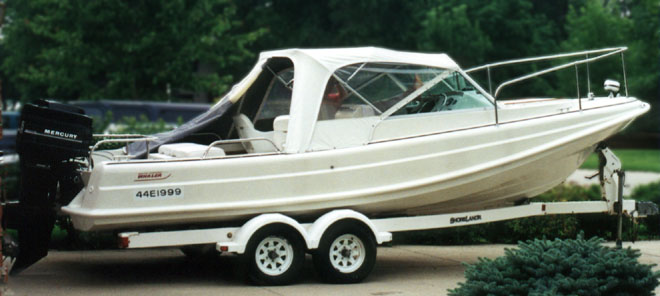 |
|
Long and Low As the aspect ratio of this photograph underscores, the 21-Revenge was a long and low boat. A 200-HP Mercury on the transom should make it fly. I am not certain if this is orignal canvas, but I have seen another Revenge with the identical set up, so perhaps this is how it came if ordered from the factory. The white or natural shade seemed popular in this era, too. PhotoCredit: JWH - Reference: 46-8 |
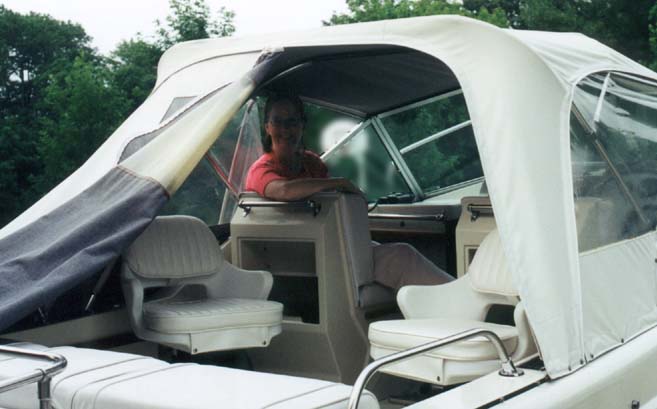 |
|
Seating For Four The dual console design had very nice molded and cushioned seats for pilot and co-pilot, with storage compartments built-in. Under the co-pilot seat a Porta-Potti could be installed as an option. The familiar Whaler twin swivel bucket seats have been mounted just behind, useful for trolling when swung to the rear. This was probably either an option or a customization using standard Whaler components. The bench seat across the stern is an owner-added item. This boat's owner liked lots of seating. PhotoCredit: JWH - Reference: 46-9 |
Close examiniation of my photo files turned up another 21-Revenge, Tom Clift's fine 1978 model. This boat has the rear engine well and cockpit railings intact. The canvas appears slightly different, too. Tom writes:
Jim, I just bought this boat last August [2000] here in Alameda, California. The engines are the original ones to the boat, 175 Evinrude and a 15 Evinrude kicker with a custom SS bracket. After trying to start it over the transom, I had an electric starter motor installed! The gelcoat is all original and the same color [it looks almost two tone in one view]. It's been outside all its life on a trailer with a full cover. The seats are two forward sitting fiberglass structures with cushions. I cut up a BW logo with harpoon and named it WAILER! Let me know if you ever use my pics, best Whaler website!
Thanks, Tom.
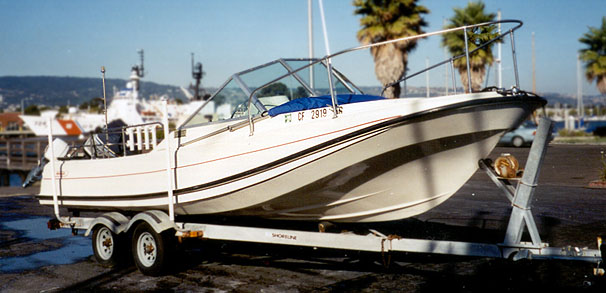 |
|
1979 Boston Whaler 21-Revenge This West Coast Whaler 21-Revenge has survived in excellent condition. Trailer stored all its life under a cover, the gelcoat looks just as it did in the showroom 23 years ago. Note the keel roller style trailer. Lighting here makes the hull look slightly darker, but the boat is all DESERT TAN hue. PhotoCredit: Tom Clift - Reference: 46-12 |
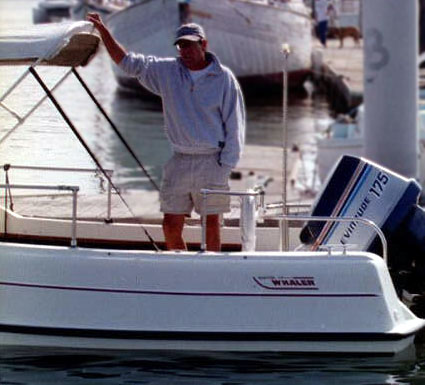 |
|
Tom Aboard WAILER Tom Clift stands in the stern of his 21-Revenge, WAILER. The boat still floats right on her lines. The engine well was wrapped with a nice stern railing. The side rails look interesting, too. PhotoCredit: Tom Clift - Reference: 46-13 |
It is possible to speculate that the unsinkable nature of the Whaler hull in concert with its extremely strong construction had engendered use of the original "sled" style hulls in offshore conditions that they really were not intended for. By 1980, probably in response to complaints about the spine crushing ride delivered by the flat, rounded bottom of the 21-foot hull, a new V-22 hull was developed at Whaler and introduced as an Outrage model and later a Revenge model. The deeper vee hullform was a big departure from Whaler's earlier designs which were evolutionary from the original Hickman Sea Sled and twin sponson approach. The new hull was more or less a constant deadrise moderate vee, the sponsons reduced to tiny vestigial elements on the bottom surface of the hull. It was a hull designed for offshore and intended to perform well in those conditions. As they had done in the earlier adaption of the 21-Revenge, Whaler developed a cuddy cabin version of the 22-foot vee hull, a new V-22 Revenge which was introduced around 1980.
The V-22 Revenge had a much larger cuddy, an actual cabin that you could walk into and sit down on a bunk. The foredeck covered about a third of the boat now; it terminated in a fixed windshield. The deck did not have an anchor locker but there was a large hatch located on centerline. The V-22 generation of Revenge had a narrower superstructure molding which did not use the full beam of the boat, fitting inside the gunwales of the original Outrage molds. The windshield was a two-panel design and was non-opening. You got to the foredeck either by walking around, although with tiny gunwales that could be a challenge in a seaway, or by coming up through the large hatch. The bow railing was placed at the usual location on the gunwales so once on the foredeck you were in limbo until you got to the bow to hang on to the rails.
Charles Warren sent some interesting photographs of one of these "V-22" Revenges. The boat appears to have been in storage for a while and not used recently, although it is not for sale. I think it is good to occassionally include a photograph or two of a Whaler that is not in Bristol condition. Most boats in Cetacea are generally in extraordinarily fine shape, and I am sure this one could be restored to a similar appearance with some work. In any case, I show it not as an advertisement or a critique, but as a look at the layout of a V-22 Revenge.
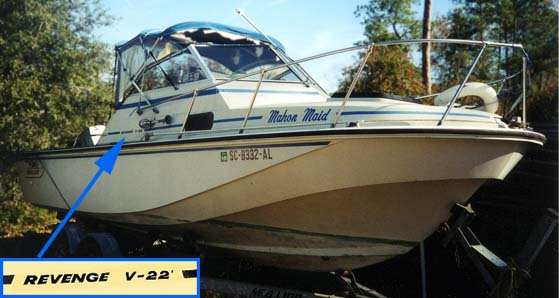 |
|
1980 Boston Whaler V-22 Revenge As the inset shows, this model is labeled "Revenge V-22 " and dates from about 1980. The bow railing layout is conventional. A large hatch provides access to the deck from the cuddy. The canvas is in need of repair. The blue trim and stripes are somewhat unusual, perhaps an option or a modification from usual black. The hull shows the lines of the "classic" Whaler 22-foot hull. PhotoCredit: Charles Warren - Reference: 46-4 |
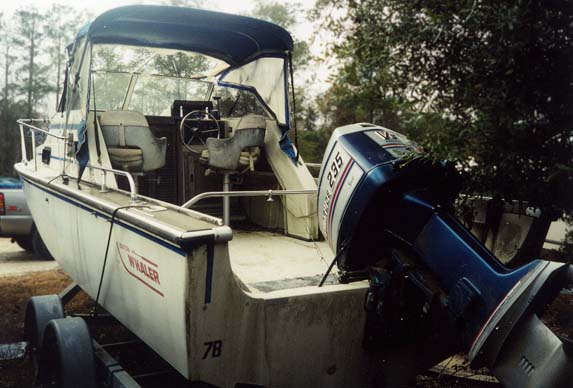 |
|
1980 Boston Whaler V-22 Revenge The molded superstructure took away some of the boat's beam and made the helm station a bit narrow. The stern has the same features as an Outrage, including the factory optional railing across the engine well. The warm climate and rains of South Carolina have set mildew to work on this boat, but with some restoration the quality Whaler gelcoat could shine like new. PhotoCredit: Charles Warren - Reference: 46-5 |
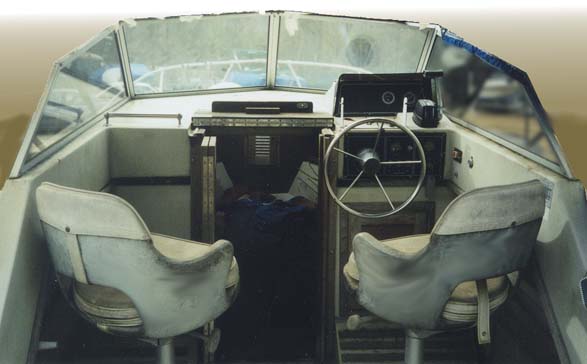 |
|
V-22 Revenge Helm The helm console is similar to the newer boats but about a foot narrower. Not yet in place are the more numerous and longer grab rails. The companionway hatch top is teak; on newer boats it becomes a sliding piece of tinted plexiglass. Seating is the standard Whaler swivel bucket seat, although this pair need some attention. Below you can see the anchor locker door in the forepeak. This detail was removed on the newer models, in an attempt to keep the anchor's muddy water out of the cabin and the berths. PhotoCredit: Charles Warren - Reference: 46-6 |
The V-22 hull turned out to be a big hit, so much so that the "vee" was soon dropped and it just became the "22". Everyone agrees that this time Whaler got it right. This is what we often call the "Classic Whaler" hullform. In the late 1980's (c.1988) the molds were changed but the modifications were mainly on the interior side (probably when the straight-across dam of the motor well was introduced) or "liner" portion. The hull form stayed essentially the same in the 22-foot boat. About this same time, the Revenge superstructure molding was substantially changed, and numerous refinements were added. The result was a boat with the seakeeping qualities of the offshore Outrage hull and the bonus of a real cuddy cabin.
The superstructure molding for the cabin and console was carried to the full beam of the boat, really eliminating the gunwales altogether. This added about a foot of width to the cockpit at the helm area, a big plus. The cabin width was not affected, since it was already limited by the interior moldings from the hull liner. In the bow, a plywood bulkhead was added to separate the cabin from the anchor locker; the louvered door on the bulkhead was eliminated and instead a deck hatch was added for anchor access. Although the anchor locker drains overboard it is not entirely sealed from the cuddy. If you stuffed a huge wave into the bow, you might get some water draining into the cabin.
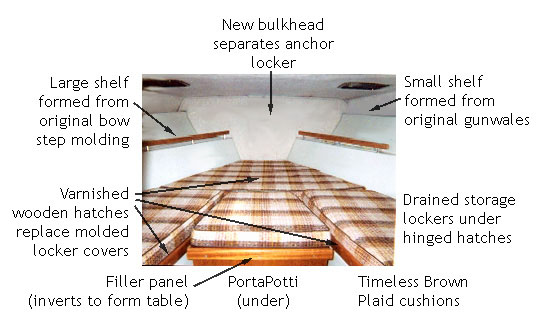 |
|
Revenge Walk-Through Cabin The cuddy cabin on a Revenge provides two nice seven-foot-long berths. This boat has the optional filler panel and cushion. In true Whaler fashion, it is constructed in such a way that it can be inverted to form a small table. PhotoCredit: JWH - Reference: 46-11 |
The big central hatch on the foredeck was eliminated and two smaller opening hatches were used instead. These are outside of the area where one walks via the bow railing, cleaning up the foredeck area and removing a trip hazard. The new hatches were just for ventilation, not deck access. As a result, the only way to get on the foredeck was via the windshield, which was made to open in the center section to allow one to walk through it, hence the name, "Walk-Through." The bow deck railing was moved far inboard so that it was no longer at the gunwales at all, but right at hand for someone coming on deck via the walk-through. This makes one feel much more secure when on deck, as long as you stay inside the railings! A bow pulpit with anchor roller which stretched another foot or so beyond the bow (with railings to match) was optional. The stainless railings were all upgraded to a welded design; the earlier Whaler railings had used standard fittings and couplings to produce the rail-to-stanchion joints.
One of the coolest features of the new Revenge was the very well-designed ladder which is used to get to the bow. The ladder slides in and out of the port side of the companionway. When you need bow access you pull it out and it makes a wonderful pathway to the foredeck. When you don't need it, you slide it back out of the way and the companionway is unobstructed. The ladder is built of beautiful teak hung on a stainless steel rod that traverses the top of the companionway. On this rod the ladder slides with a nylon bushing. The feet of the ladder have similar slides, and the whole device just works beautifully. It adds a great yacht look, slides perfectly, and make a very safe and easy path to the bow. It is a wonderful solution to the problem of how to get from the cockpit to the foredeck.
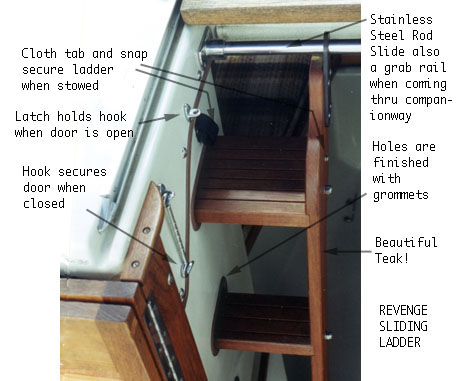 |
|
Ladder Details Attention to detail is often what separates great from good. The design of the disappearing companionway ladder in the REVENGE series is an example. No individual part or molding is complex, but together they form the perfect solution to the problem: how to share the space of the companionway for both a ladder and a passageway. In this view the ladder is seen halfway out. PhotoCredit: JWH - Reference: 46-10 |
Another detail: on the foredeck side the coaming at the base of the windshield has a well-proportioned step molded into it. As you come through the opening in the windshield the step gives you a nice flat spot for your footing on the otherwise sloping coaming of the windshield base.
When a builder makes a particular model of boat for a while, they tend to make little refinements to it, like the sliding ladder, the molded step in the windshield coaming, and the layout of the bow railing. It is rare that all this just happens on the first boat; it usually evolves. By 1986 all of these little details had evolved into the last of the Revenge models, making it a great little cuddy cabin boat on a great Classic Whaler hull.
Some folks have complained that I "sit" on their pictures, but actually they sit on me--I am often electronically buried in piles of them in my e-Mail mbox! Charles Warren has been pretty patient; he sent me these almost a year ago! I recently used a couple of them to illustrate the article on trailers and ramps. The boat looks so nice that it deserved more exposure. It is a fine example of the latest of the Revenges. The senior Mr. Warren wrote (back in December 2000):
"Jim - Here are some pictures of my son Steve's "new" 1986 22' Revenge which he purchased in September of [2000]. The original owner kept the boat in the water and put it on the trailer in the winter for storage. We plan to remove the bottom paint. The pictures are on the first day of ownership, a lot of elbow grease and TLC have gone into it since then. [The pictures] show the boat on the way home. The motors are 1995 models. Rear curtains completely enclose the cabin. It is equipped with outriggers and a single down rigger. The 1998 Explorer [cropped in photo] can pull it locally with little stress. This weekend [i.e., a year ago] it will be going up the intracostal from Mt. Pleasant to Pawleys Island, SC for a Christmas weekend of cruising the Waccamaw, Pee Dee and Black rivers and some offshore fishing." [By the way, I love that "Pee Dee" river; it was in the NY Times crossword puzzle recently--jimh.]
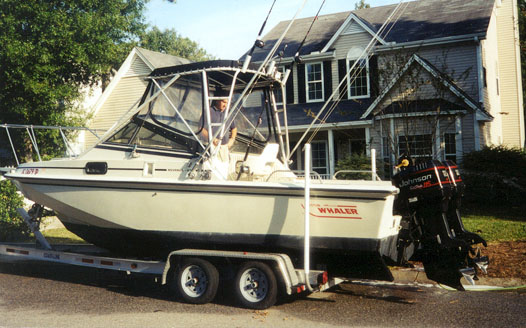 |
|
1986 Boston Whaler 22-Revenge Walk-Through By 1986 the Revenge was in its final stage of evolution, the "Walk Through" model. The crafty adaptation of the Outrage-22 hull and a new forward molded cabin assemblly produced this terrific cuddy cabin Whaler. An owner-added combination radar arch and permanent canvas top create excellent shelter. Twin 1995 115-HP Johnsons on the cut transom will provide plenty of power. As often seen, the trailer is a "float-on" style bunk design. New owner Steve Warren checks out the fishing gear. PhotoCredit: Charles Warren - Reference: 46-1 |
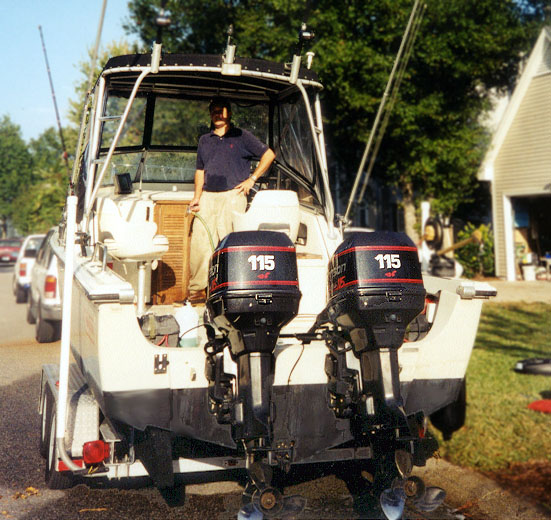 |
|
1986 Boston Whaler 22-Revenge Walk-Through The 22-foot hull has evolved from the early "Sea Sled" days of Whaler into a moderate vee with about 18-degrees of deadrise as seen here. The canvas and glass enclosure appear to be a custom job in coordination with the radar arch and top. Say, for a salt-water boat those engines look wonderful! PhotoCredit: Charles Warren - Reference: 46-2 |
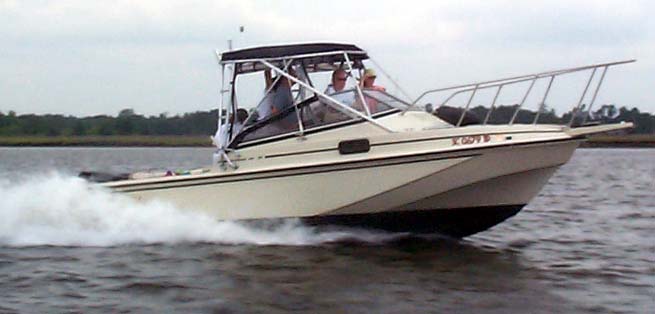 |
|
22-Revenge on Cruise Here is Steve Warren's Revenge underway. With six aboard there is still plenty of power to maintain a fast cruise on plane. Because the helm station is located slightly farther forward than on an Outrage, the helmsman's ride may be just a bit rougher on a Revenge. The lines of the cuddy cabin have held up well; they looked neither dated or "Euro". To me they seem just...classic! PhotoCredit: Stephen Warren - Reference: 46-3 |
Now we've had a bit of a history lesson, a look at three variants of Revenges, and a chance to see Seve Warren's fine boat, but still unresolved is the question of the "revenge." Who is getting revenge and on whom?
Consider Dick Fisher's sense of humor and his fondness for word play. He stated outright that "Boston Whaler" was "a joke", a contradiction because Boston was never a Whaling port and Whale Boats were pointy on both ends while his boat was pointy on neither end. So what is the irony, the satire, the conceit of a Whaler named "Revenge"? I think it comes from the idea that Boston Whaler was known for making open boats, not the closed-deck dual-console models that most other builders offered. They probably told Dick his original boat would never sell, and now he was getting back at them, coming right into their market with his own brand of of boat, his own Boston Whaler...Revenge.
DISCLAIMER: This information is believed to be accurate but there is no guarantee. We do our best!
The page has been accessed 122904 times.
Copyright © 2001 by James W. Hebert. Unauthorized reproduction prohibited!
This is a verified HTML 4.0 document served to you from continuousWave
URI: http://continuouswave.com/whaler/cetacea/cetaceaPage46.html
This article first appeared December 10, 2001 and was revised several time by December 15, 2001.
Last modified: Sunday, 01-Jun-2003 14:56:38 EDT
Author: James W. Hebert